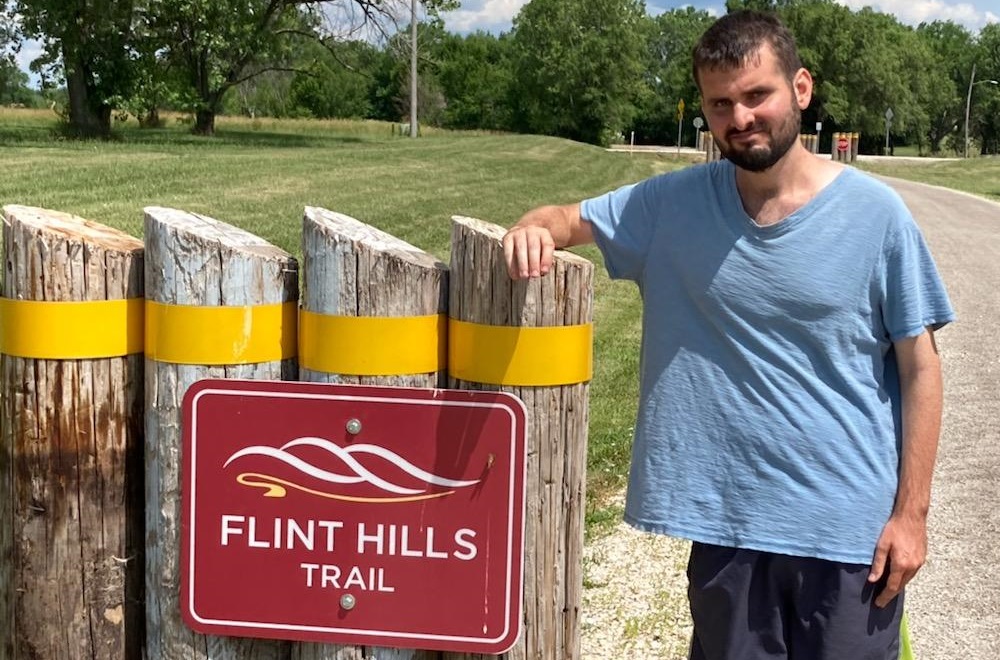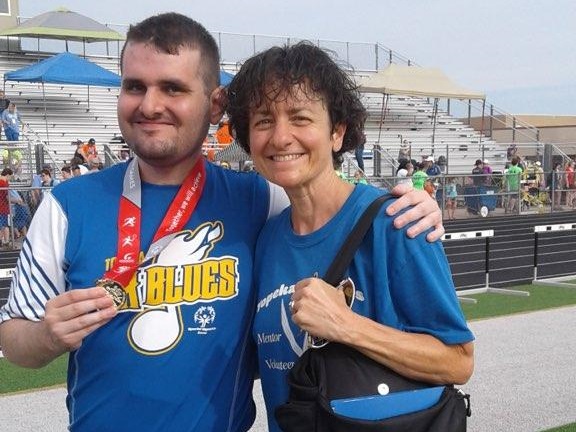When Cort Huffman’s doctor told him he had high blood pressure, putting him at risk for developing heart disease, Huffman got scared. Then, he fairly quickly turned that fear into resolve.
Huffman, who has autism, weaned himself off sugary drinks. He began walking several miles a day and participating in Special Olympics fitness challenges. Within a year, he lost 30 pounds and his blood pressure dropped to a healthy level.
“I’ve always tried to stay active. But when I found out I had borderline high blood pressure I got very serious about getting healthy,” said Huffman, 27, who lives in rural Admire, Kansas, and was diagnosed with hypertension when he was 25.
 Among 10- through 17-year-olds, for example, 20% of those with disabilities but 15% of the non-disabled were obese, according to one federal Centers for Disease Control and Prevention analysis. Researchers for Special Olympics, using 2018 and 2019 data, concluded that 48% of youth with intellectual disabilities in North America — most of those youth were from the United States — were overweight or obese. That compared to about 31% of U.S. adolescents, overall.
Among 10- through 17-year-olds, for example, 20% of those with disabilities but 15% of the non-disabled were obese, according to one federal Centers for Disease Control and Prevention analysis. Researchers for Special Olympics, using 2018 and 2019 data, concluded that 48% of youth with intellectual disabilities in North America — most of those youth were from the United States — were overweight or obese. That compared to about 31% of U.S. adolescents, overall.
Some experts have concluded that such health disparities are more related to how disabled people are treated and perceived than with biological factors.
“In general, it’s an invisible population and people don’t even think of kids and adults with intellectual disabilities as being able to be physically active. And we know that’s just not true,” said pediatrician Alicia Bazzano, chief health officer for Special Olympics.
Little by little, researchers from that international sports organization and from academia are trying to change attitudes and close the fitness gap by tailoring programs for youth with such intellectual and developmental disabilities as autism, Down syndrome, fetal alcohol syndrome and fragile x syndrome.
THERE’S LESS RESEARCH ON OBESITY AMONG THE DISABLED
While there’s been a plethora of research on obesity in the United States, in general, Bazzano said, only in recent decades have researchers started investigating overweight among people with intellectual disabilities.
“The prevailing attitude on the part of healthcare professionals is that people with intellectual disabilities don’t have a good quality of life. It’s changing that attitude that we’re also working on,” Bazzano said.
She cited “Misperceptions Of People With Disabilities Lead To Low-Quality Care: How Policy Makers Can Counter The Harm And Injustice,” a study that the journal Health Affairs published in April 2021, arguing for more data on the overall health of people with disabilities.
A groundbreaking 2010 study had concluded that adolescents with autism or Down syndrome were two to three times more likely to be obese than their non-disabled peers. In turn, they were more likely to have a host of secondary health conditions such as high blood pressure, high cholesterol, diabetes, depression and low self-esteem.

Partly by walking one of his favorite hiking trails, Cort Huffman shed 30 pounds and reversed his high blood pressure.
Since that landmark study, some of the most robust research on people with intellectual disabilities has been conducted by Special Olympics, in part because the organization has access to many potential study participants.
Bazzano said Down syndrome and Prader-Willi syndrome, as examples, genetically pre-dispose individuals to weight gain. “Nonetheless, the primary factor is lack of access to opportunities for inclusive health,” she said, “in particular, inclusive fitness opportunities, nutrition information and programming that’s appropriate for individuals with intellectual disabilities.”
MORE ACTIVITIES AND DIETS ARE BEING TAILORED FOR THE DISABLED
Incrementally, those fitness opportunities are growing as research expands. Thomas Higbee, a professor of special education and rehabilitation at Utah State University, co-authored a study, published in November 2020, finding that physical activity directed partly by photographs made kids with autism more active.
Those guided activities include walking, shooting baskets on a child-sized hoop and bear-crawling. Higbee said that kind of assisted exercise should also work well for kids with other types of intellectual disabilities, adding that he’s used them for his own kids, who are not disabled.
Those visual guides “essentially teach the kids to cue themselves to engage in sequences of behavior, so they don’t have to rely on adults to tell them what to do,” Higbee said, adding that the activities hone youths self-reliance and independence.
While Higbee’s study used photographic cues, other studies have tracked kids being led through activities via videos. And Higbee said that even text-only activities could be useful for older kids who can read.
“A large part of it is the structure,” Higbee said. “The type of cue that you use really is going to vary depending on the needs of the learner. We use pictures because we work with really young kids.“
PRO WRESTLERS HELPED DEVELOPED FITNESS PROGRAMS
Special Olympics also developed, as one example, a “Fit 5 Guide,” which challenges participants to exercise five days per week, eat five fruits and vegetables per day and drink the equivalent of five bottles of water per day.
Special Olympics has also teamed up with the World Wrestling Entertainment professionals for a series of workout videos featuring people with disabilities.
“It’s the first time, that we know of, that a workout video series is specifically designed for youth with intellectual disabilities,” Bazzano said. “There’s a real difference when you see yourself in the videos. That’s been wildly popular.”
Kids as young as two with intellectual disabilities are the focus of play-based physical activities that Special Olympics has developed, said Ashlyn Smith, one of the organization’s senior researchers. Those activities include adaptations for kids using wheelchairs, feeding tubes or other supportive devices.
The key, she said, is for parents, teachers and other caregivers to identify what activities the kids can and like to do and use them to increase daily movement. “It’s really easy to look at young children with intellectual and developmental disabilities and see what they can’t do, instead of looking for opportunities to capitalize on their strengths,” Smith said.
For Cort Huffman, self-motivation has proven to be one of his strengths. While fitness centers were closed during the COVID-19 pandemic, he went walking on a Rails to Trails Conservancy path near his house or on the track at a local high school. When the weather forced him indoors, he turned to his treadmill. When his mom wasn’t available to drive him to the track or the trail, he hiked around the family farm.
He allowed himself no excuses to neglect his quest to get healthier. Do “some daily exercise, even if it is only 10 or 20 minutes,” Huffman said. “Anything is better than nothing.”




























